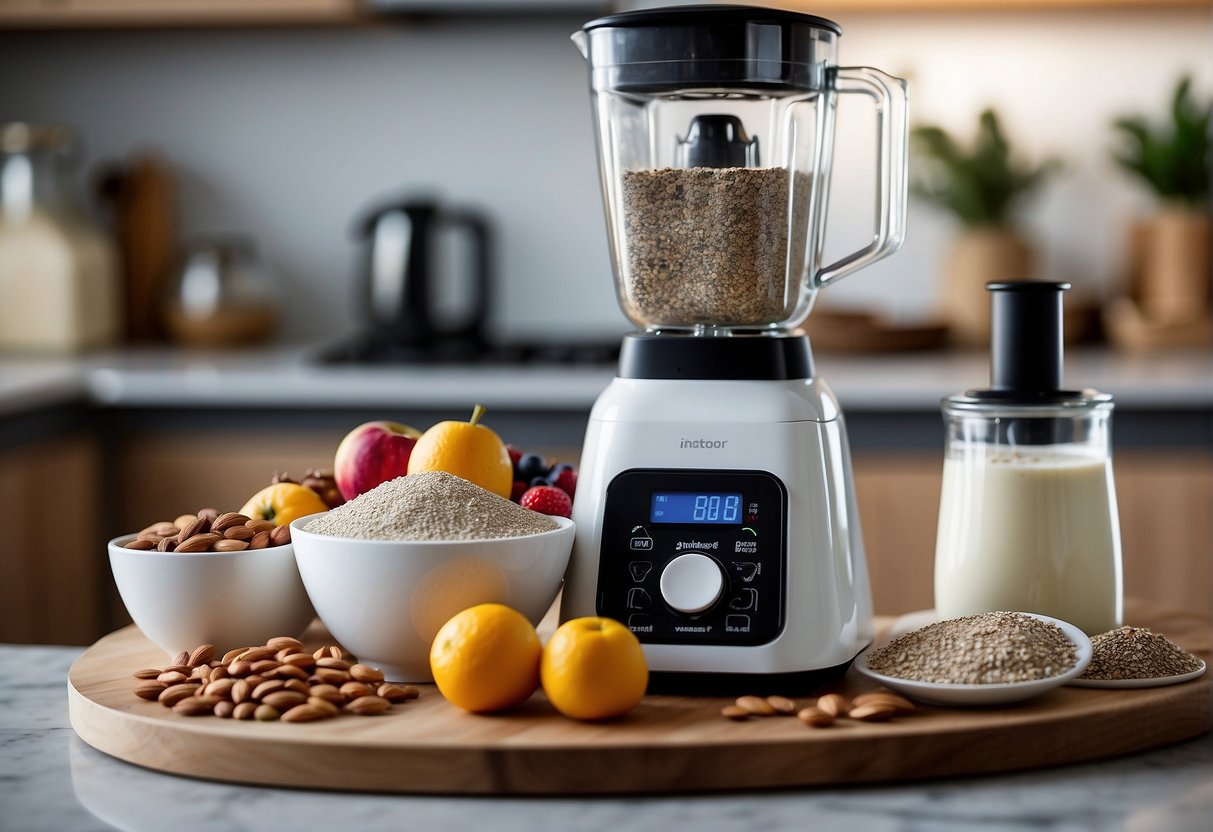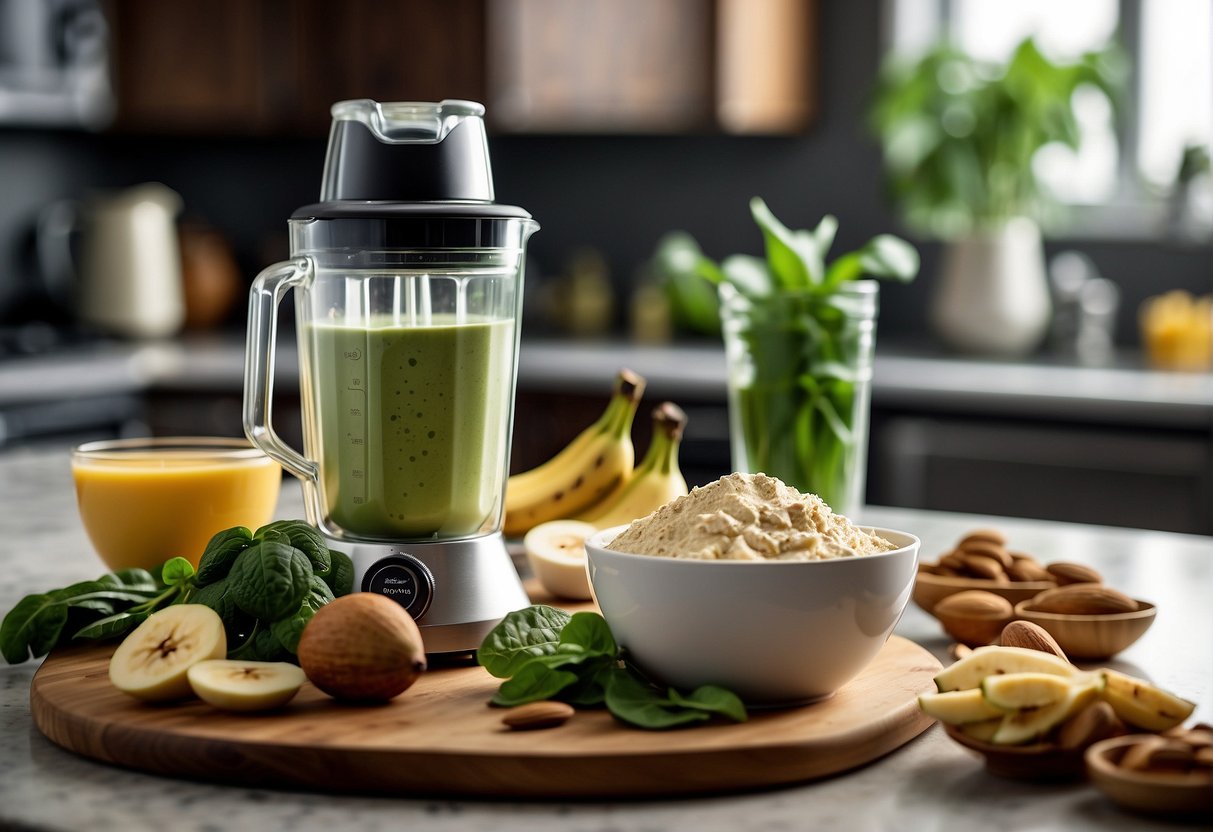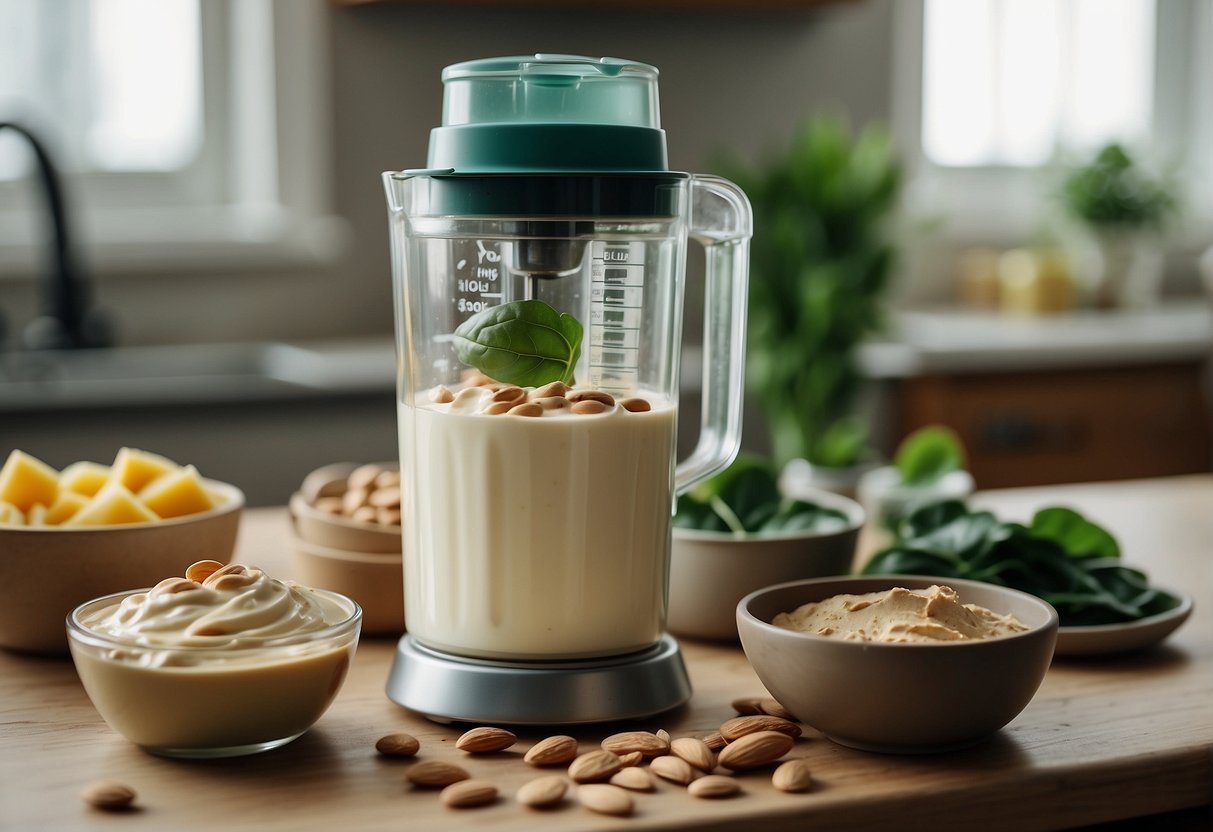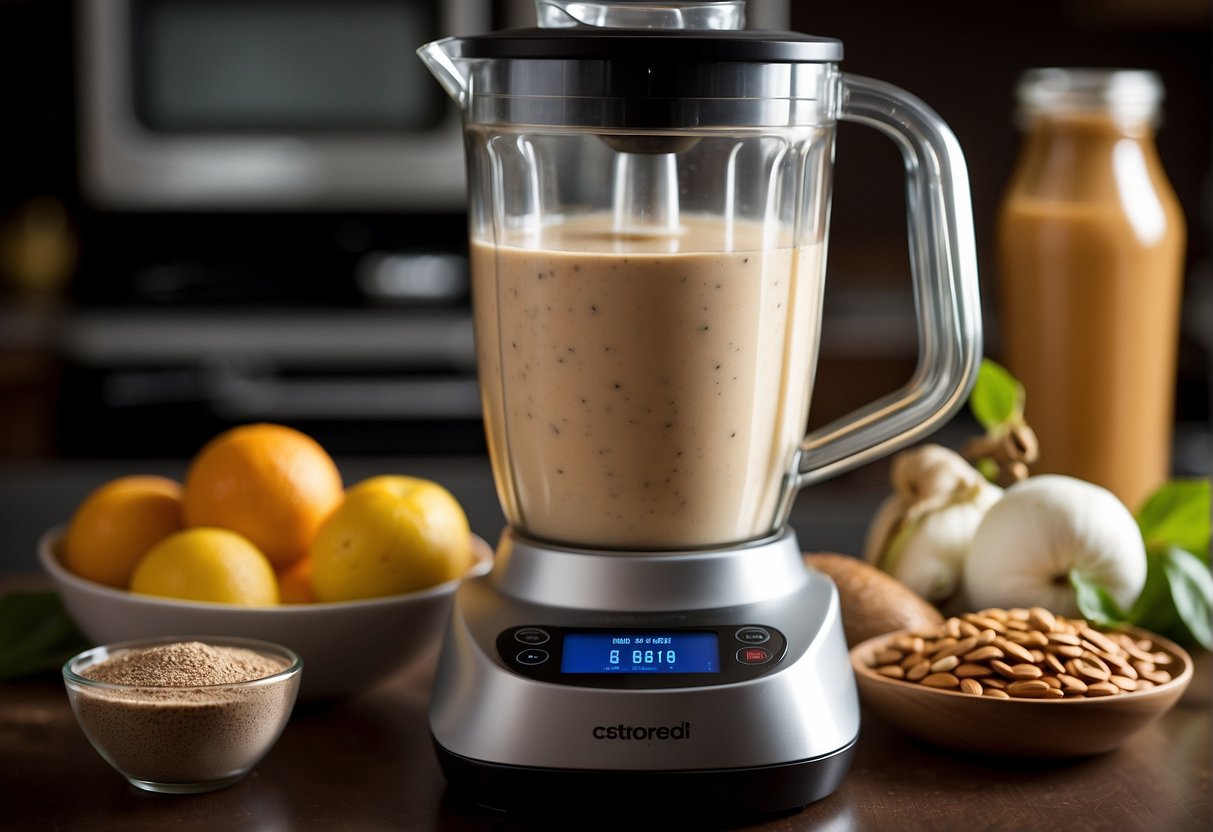Understanding Protein in Smoothies
When I make a high-protein smoothie, I’m aiming to up my nutrition game. Protein is a powerhouse nutrient that’s essential for muscle repair, growth, and overall health. But how do I pack that protein punch into a delicious smoothie? Well, it’s about choosing the right ingredients.
First up, protein powders—these are a go-to for many. Whether it’s whey, soy, or plant-based protein powders like pea or hemp, a scoop can significantly boost protein content. For my vegan friends, plant-based protein powders are a perfect fit. They’re derived from things like brown rice or nuts and are just as effective.
But hey, not everyone’s into powders, right? I also rely on whole foods for protein. Dairy can be a great option—I’m looking at ingredients like Greek yogurt or milk. If I’m leaning towards a plant-based or lactose-free diet, then options like almond milk or soy milk work wonders. They’re lower in protein than dairy, but when combined with other foods, they do the trick.
Now, let’s talk about some yummy extras:
- Chia seeds or flaxseeds: They’re small but mighty. I toss them into my smoothie for a fiber and protein kick.
- Nuts and nut butters: Hello, peanut butter smoothie! Nuts are great for adding healthy fats and protein.
Here’s a quick glance at what I might include:
| Ingredient | Protein Content |
|---|---|
| Protein powder (1 scoop) | 15-25g |
| Greek yogurt (1 cup) | 23g |
| Almond milk (1 cup) | 1-2g |
| Peanut butter (2 tbsp) | 7-8g |
I always keep in mind that a balanced drink is about more than just protein—it’s a symphony of nutrients that work together. Healthy fats, fiber, vitamins, and minerals, they all play a part in a nutritious, high-protein shake. So next time you’re blending, think of these friends too.
Choosing Your Protein Sources

When I make my smoothies, I focus on incorporating protein to keep me full and fueled. My go-to proteins fall broadly into two categories: dairy-based and plant-based options. Also, there are certain additional protein-boosters that work like a charm. Here’s how I jazz up my smoothies with a protein punch.
Dairy-Based Proteins
Dairy proteins are a no-brainer for me when it comes to smoothies. They blend well and add a creamy texture:
- Yogurt: A great base for smoothies. I prefer using Greek yogurt because it’s thicker and packs more protein.
- Milk: Simple yet effective. Swapping water or juice with dairy milk can bump up the protein content considerably.
- Cottage Cheese: Don’t knock it ’til you try it! Cottage cheese makes smoothies incredibly smooth and adds a milkshake-like quality.
Plant-Based Proteins
For anyone dairy-free or vegan, plant-based proteins are my alternative. They’re just as effective at adding that essential protein kick:
- Nuts and Seeds: Almonds, chia seeds, and flaxseeds are some of my favorites. They not only add protein but also healthy fats that make for a satisfying smoothie.
- Nut Butters: A spoonful of almond butter or peanut butter can radically boost the protein content and flavor.
- Tofu: This might sound odd, but hear me out. Silken tofu is almost tasteless, and it adds a silky, protein-rich component to any smoothie.
Additional Protein-Boosters
Sometimes I like to throw in a little something extra for an additional protein punch:
- Protein Powder: There are many varieties on the market, but I tend to lean towards natural and unflavored options.
- Powdered Milk: This is a secret weapon for increasing protein without altering the flavor too much. Just a tablespoon or two can make a difference.
Base Ingredients for Creaminess

When I make my high-protein smoothies, I focus on ingredients that blend up thick and creamy. Let’s dive into some specific base ingredients that not only contribute to the creaminess but also ramp up the protein content.
Fruits as a Base
I often start with bananas because they’re a staple for that perfect creamy texture in smoothies. I’ll toss in a frozen banana to make my smoothie rich without needing ice cream or yogurt. Plus, bananas are a quick source of energy and blend well with other ingredients. Mangoes are another go-to for me; they’re sweet, lusciously thick, and blend nicely with frozen fruit to create a satisfying base.
Non-Dairy Alternatives
Now, for non-dairy alternatives, I find almond milk and soy milk fantastic for creaminess. Almond milk is lighter and has a pleasantly nutty flavor, while soy milk tends to be richer and adds a bit more protein. And let me tell you, adding a bit of avocado will not only thicken the texture but also offers healthy fats. Don’t forget about coconut water—it’s not as creamy, but it’s super hydrating and gives tropical vibes when paired with the right fruits.
Enhancing Flavor and Nutrition

When I whip up a high-protein smoothie, I’m not just thinking about protein content. I’m aiming for that sweet spot where taste meets nutrition. It’s all about blending the right ingredients to enhance both flavor and health benefits.
Sweeteners
I like adding a hint of sweetness to my smoothies without the refined sugar. Honey is my go-to natural sweetener because it adds a floral note. If I’m after a cozy, warm flavor, maple syrup does the trick and it pairs nicely with cinnamon. Both of these are not just sweet but also bring in a touch of their own unique antioxidants.
- Honey: Also adds antimicrobial properties.
- Maple Syrup: Rich in minerals like zinc and manganese.
- Dates: Nature’s candy, they’re perfect for adding sweetness and fiber.
Greens and Veggies
You can’t beat spinach and kale when it comes to slipping greens into your smoothie. These aren’t just fillers; they’re nutritional powerhouses loaded with vitamins, minerals, and fiber. I’ve found that spinach is milder and blends seamlessly, while kale adds a bit more body and earthiness.
- Spinach: High in iron and magnesium, plus it’s super soft, so it blends well.
- Kale: Packed with antioxidants and adds a nice thick texture.
Superfoods
Oh, the options for superfoods are endless! I lean towards berries and flaxseeds. Berries offer a burst of flavor and antioxidants, while flaxseeds grant my smoothie a boost of omega-3s. And don’t forget vanilla protein powder for a sweet, rich flavor plus the extra protein kick.
- Berries (strawberries, blueberries, etc.): A sweet touch full of flavor and high in fiber.
- Flaxseeds: A spoonful can supply omega-3s, fiber, and even some protein.
Texture and Consistency Adjustments
When I’m making a high-protein smoothie, getting that just-right texture can make or break the experience. I like my smoothies creamy and thick, almost like they can hold a spoon upright. Here’s how I nail the texture every time:
-
Ice: It’s a go-to for a frosty chill, but too much can water things down. So, I add ice cubes judiciously, making sure to blend well.
-
Frozen Banana: Oh, the magic of a frozen banana! This fruit is my secret weapon for creaminess. Plus, it doubles as a natural sweetener.
My Rough Guide for Creamy Consistency
| Start With | Then Adjust |
|---|---|
| Handful of ice | Add more for frostiness |
| 1 frozen banana | Cut back if too thick |
We can’t forget that texture also depends on what else goes into the blender. If my smoothie feels too thin, here’s my trick: I throw in some granola. Not only does it add a satisfying crunch, but it also thickens the blend. A couple of tablespoons should do the trick.
Remember, these are just guidelines. I tweak as I go because, let’s face it, the perfect smoothie consistency is a personal thing. Happy blending!
Toppings and Extras

When I make a high-protein smoothie, the right toppings and extras can turn it from a simple shake into a delicious powerhouse. I love playing around with various add-ins for that extra flavor and nutrition boost.
Fruits and Berries
My go-to for natural sweetness and antioxidants has got to be berries. I toss in a handful of raspberries, blueberries, or blackberries for a punch of flavor. Sometimes, I go wild with a mix, adding mixed berries for some variety and extra nutrients.
- Raspberries: A bright addition that’s packed with fiber.
- Blueberries: Bursting with antioxidants and a sweet pop of taste.
- Blackberries: They give a lovely tartness and are full of vitamins.
- Mixed Berries: A combo that not only tastes great but also looks fantastic on top of my smoothie.
Seeds and Nuts
Seeds and nuts add incredible texture and are jam-packed with healthy fats and proteins. I am partial to sprinkling chia seeds or ground flax on top for that satisfying crunch and omega-3s.
- Almonds: I slice them thinly and scatter them over my smoothie for a nutty bite.
- Walnuts: Chopped for an earthy, rich flavor plus some brain-boosting omega-3s.
- Chia Seeds: These tiny seeds expand, adding an interesting texture.
- Ground Flax: A subtle, nutty flavor with a dose of fiber that mixes well with any smoothie.
Alternative Sweeteners and Flavors
When I want a dash of extra sweetness without reaching for sugar, I go for natural sweeteners. A drizzle of honey or a splash of maple syrup does the trick without overpowering the other flavors.
- Coconut: A sprinkle of shredded coconut works for a tropical twist.
- Chocolate-Peanut Butter Protein Shake: Sometimes as a special treat, I’ll blend in a spoonful of chocolate-peanut butter for richness and added protein.
- Berry-Kefir Smoothie: A swirl of berry-kefir can introduce probiotics and tangy sweetness to my morning routine.
Healthy High-Protein Smoothie Recipes

In my quest for a formidable morning start, I’ve found high-protein smoothie recipes to be both satisfying and delicious. Whether you’re jonesing for a classic flavor or something more avant-garde, below you’ll find some of my most cherished smoothie concoctions.
Classic Smoothie Favorites
The Peanut Butter Banana Smoothie is an all-time classic that never disappoints. I blend it with a hefty scoop of protein powder to kick up the protein content for a post-workout recharge. For a berry twist, I often go for a Blackberry Smoothie, packing it with antioxidants and at least 15 grams of protein per serving for sustained energy levels.
Creative Combinations
I love experimenting with flavors, and my Mango Smoothie hits the spot with its tropical zest. To amp up the protein, adding Greek yogurt works like a charm. Then there’s the Raspberry-Peach-Mango Smoothie Bowl, a trifecta of fruits that not only tastes amazing but also fuels my body with protein when I stir in some chia seeds or nut butter.
Protein-Packed Bowls
The range doesn’t stop at drinks though; my Mango-Almond Smoothie Bowl is a frequent go-to breakfast option. The combination of almond butter and protein powder, folded into the mix, creates a protein powerhouse that keeps me full until lunchtime. Plus, it’s an excuse to get creative with toppings – think sliced nuts and fresh fruit.
Preparation and Blending Techniques

When I’m about to whip up a high-protein smoothie, I always start with the blender—I make sure it’s clean and sharp. A good blender is key. It’s like, you wouldn’t bring a butter knife to a sword fight, right? So I check my blender for any lingering smells from yesterday’s mix while eyeing my ingredients on the counter.
Now, for convenience, I’m all about those pre-made smoothie packs. If you haven’t tried them, trust me, they’re a game-changer. I grab one from the freezer, and it’s like half the work is already done. Toss it into the blender; no muss, no fuss.
But let’s talk consistency, which is super important in the realm of smoothies. I like mine thick and creamy, like they could practically stand up a spoon. If it’s too thin, I throw in a few ice cubes or some frozen banana slices to thicken it up. On the flip side, if my smoothie is too thick, a splash of almond milk usually does the trick. Here’s the deal: start on a low setting, then gradually ramp up the speed. This technique prevents those dreaded air pockets and makes for a smoother blend.
So basically, a good high-protein smoothie comes down to a solid blending strategy. Begin with a clean, powerful blender, convenience with smoothie packs if that’s your jam, and nail down the perfect consistency for a top-notch drink. Cheers to that!
Considerations for Dietary Restrictions

When I make a high-protein smoothie, I always consider various dietary needs. Whether it’s cutting down on fats and carbs, or avoiding sugar, it’s essential to find alternatives that align with specific health and nutrition goals.
Low-Fat and Low-Carb Options
For those keeping an eye on fat and carbohydrate intake, selecting the right ingredients is crucial. I opt for low-fat dairy or plant-based milks, such as almond or cashew milk, which are both low in fat and carbs. Additionally, choosing a protein powder that’s low in carbohydrates can make a huge difference – some protein powders are designed specifically for keto or low-carb dieters. To add creaminess without the fat, avocado is a great choice – just remember that it does contain some natural fats, albeit healthy ones.
Sugar-Free Alternatives
If I want to dodge added sugars, I always check labels for unsweetened protein powders and use whole fruits to add natural sweetness. Instead of honey or syrup, I might throw in some organic stevia or erythritol for that extra sweet kick without the sugar rush. For a truly sugar-free option, I often include dairy-free yogurt or kefir that’s labeled as sugar-free, ensuring that my snack remains within my dietary bounds.
Nutritional Benefits for Health and Fitness

When I whip up a high-protein smoothie, I’m not just thinking about flavor—I’m also focusing on the nutritional benefits for health and fitness. Getting enough protein is crucial since it’s the building block of muscles, and a smoothie loaded with this macronutrient helps with muscle repair and growth, especially after a workout.
Here’s what I toss into my blender to make my smoothies not just tasty but also a powerhouse of nutrition:
-
Protein sources: I often add a scoop of my favorite protein powder (choose one that’s low in sugar but high in protein), which helps to keep me feeling full and supports muscle mass maintenance. For some great examples, see how Johns Hopkins Medicine outlines the role of protein in smoothies.
-
Healthy fats: I don’t shy away from adding a tablespoon of almond or peanut butter. Not only do they add creaminess and flavor, but they also provide the healthy fats my body needs. Healthy fats are essential for nutrient absorption and heart health.
-
Fiber: To keep my digestive system happy, I make sure to include sources of fiber such as flax or chia seeds. They’re amazing for a smoothie’s texture and for keeping me regular.
-
Probiotics: A dollop of Greek yogurt or kefir not only makes the smoothie lusciously thick, but it also adds probiotics which are great for my gut health.
-
Vitamins and minerals: I pack my smoothies with fruits and veggies because they’re bursting with vitamins, minerals, and antioxidants. Frozen berries, for example, maybe linked to heart health and are full of these key nutrients.
My go-to recipe is a balance of these components, ensuring I’m fueling my body right, whether I’m gearing up for the day or winding down after a gym session. The right smoothie doesn’t just taste good; it supports my overall health and fitness goals.
Storage and On-the-Go Solutions
When I’m whipping up a high-protein smoothie, I always think about storage and travel. Here’s how I make sure my nutritious snack doesn’t go to waste and stays fresh when I’m on the go.
In the Fridge:
- I use mason jars because they’re awesome for sealing in the freshness.
- I make sure the lids are on tight to keep everything sealed and secure.
Freezer Friendly:
- I often pour my smoothie into ice cube trays. Once they’re frozen, I pop them into a bag. It’s a perfect portion-controlled snack for later.
Transportation:
- I’m a big fan of insulated flasks. They keep my smoothie cool and thick.
- Sometimes, I go for reusable silicone bags. They’re lightweight and don’t leak.
| For Quick Sips | For Longer Commutes |
|---|---|
| Travel mugs with straws | Vacuum-sealed bottles |
| Small thermos flasks | Insulated cooler bags |
Pro Tips:
- I always pre-pack dry ingredients the night before in a small container.
- If I blend in advance, I give my bottle a good shake before drinking.
By following these tips, I can enjoy my high-protein smoothie anytime, anywhere without a hitch!
Professional Tips from Dietitians

When I chat with dietitians, they always emphasize the importance of balance in nutritious smoothie recipes. Here’s what I’ve gathered from their expert advice:
-
Protein Powders: A scoop of protein powder can significantly boost your smoothie’s protein content. I make sure to opt for a high-quality powder that doesn’t come with a lot of added sugars or artificial ingredients.
-
Whole Foods: For an added nutrition punch, dietitians recommend incorporating whole foods like Greek yogurt or kefir, which also introduce a creamy texture. A serving of Greek yogurt can provide both protein and probiotics.
-
Nut Butters: A spoonful of almond or peanut butter can add flavor and healthy fats alongside more protein, making my smoothie more filling.
-
Seeds: I often toss in chia or flax seeds for an extra dose of protein, plus they’re an easy way to sneak in omega-3 fatty acids.
-
Vegetables: Believe it or not, spinach or kale can add a subtle nutrition boost without overpowering the taste. Seriously, I hardly notice they’re in there!
Here’s a quick table with protein-rich additions I use:
| Add-In | Protein (approx. per serving) |
|---|---|
| Protein Powder | 15-25g |
| Greek Yogurt | 10-20g |
| Almond Butter | 6-8g |
| Chia Seeds | 2-4g |
| Spinach | 1-2g |
Remember, the trick is to keep it tasty yet nutritious. I often look for inspiration from dietitians’ crafted smoothie recipes to ensure I’m not overdoing it with the protein—it’s all about that sweet balance!
Understanding Protein Requirements

When I’m planning my diet, protein is a top priority for me—it’s essential for muscle repair, immune function, and overall health. So, if you’re like me and trying to make a high-protein smoothie, understanding how much protein you need is crucial.
First off, let’s talk nutrition. My daily protein requirement depends on several factors like my age, gender, weight, and level of activity. Generally, though, adults need around 0.8 grams of protein per kilogram of body weight. If I’m more active or looking to build muscle, I might bump that up.
Here’s a quick reference table for average protein needs based on activity level:
| Activity Level | Protein (grams per kg of body weight) |
|---|---|
| Sedentary | 0.8 |
| Moderate | 1.0 – 1.2 |
| Active | 1.2 – 1.7 |
Now, a high-protein diet is particularly relevant to folks who are into fitness or looking to manage their weight. Each serving of a high-protein food contributes to that daily goal. For example, if I weigh 70 kg and am moderately active, I am aiming for about 84 grams of protein a day—or more if I want that extra protein punch.
Incorporating a variety of protein sources into my smoothies is the way to go—I can use Greek yogurt, nuts, seeds, or even pea protein powder. This not only helps me meet my protein requirements but also keeps my smoothies fresh and exciting. Plus, it’s good for my overall health and keeps my taste buds happy.
Remember, these are just averages, and my needs may differ. It’s always a good idea to talk to a healthcare provider or dietitian if I’m unsure about how much protein is right for me.
Customizing Your Protein Smoothie

When I’m creating my high-protein smoothies, the focus is always on flavor and health. Finding that sweet spot where taste meets nutrition is the key. For the protein base, I often use Greek yogurt or cottage cheese, both of which make the smoothie creamy and are packed with protein. If I want to keep it vegan, tofu or a scoop of a plant-based protein powder works wonders.
To keep things interesting, I’ll throw in a variety of fruits for natural sweetness. Strawberries and bananas are my go-to options, but sometimes I’ll mix in some blueberries for an antioxidant kick. If I’m feeling adventurous, a handful of spinach or kale blends in without overpowering the other flavors and ups the healthy ante.
- Milk or Nut Milk: To adjust the consistency to my liking, I’ll add regular milk or a nut milk like almond or cashew. It’s a simple way to add a bit more protein to my smoothie.
- Nut Butters: For an extra protein punch, I lather in some almond or peanut butter. These not only amp up the creaminess but also make the smoothie more satiating.
- Seeds: Sometimes I sprinkle in some chia seeds or flaxseeds for added fiber and protein content.
| Ingredients | Protein Content |
|---|---|
| Greek Yogurt | High |
| Cottage Cheese | High |
| Tofu | Moderate-High |
| Protein Powder | Variable |
| Nut Butters | Moderate |
| Seeds | Moderate |
When it comes to recipes, I don’t stick to strict formulas. Instead, I focus on the balance between the protein sources and the rest of the ingredients to keep my smoothie both healthy and delicious. Remember, the best smoothie is the one you enjoy and keeps you fueled!
Frequently Asked Questions

I get tons of questions about ramping up the protein in smoothies. If you’re curious too, these FAQs cover some rock-solid tips and ideas.
What are some natural ingredients to boost protein content in smoothies?
I love working with ingredients like Greek yogurt, hemp seeds, and chia seeds to naturally enhance my smoothie’s protein level. These are simple to toss in and don’t mess with the flavor too much.
Can you suggest any high-protein fruit combinations for a smoothie?
Absolutely! Pairing fruits like bananas with nut butters or blending berries with Greek yogurt provides a one-two punch of flavor and protein.
What’s a good recipe for a post-workout protein smoothie?
After a workout, my go-to is a smoothie with bananas, a scoop of protein powder, almond milk, a spoonful of almond butter, and a few ice cubes. It’s replenishing and protein-packed.
How can I make a protein-packed breakfast smoothie?
For breakfast, I blend rolled oats, Greek yogurt, a handful of strawberries, a bit of honey, and some almond milk. It keeps me full and energized till lunch.
Which seeds or nuts can increase the protein in my smoothie?
I often opt for flaxseeds, pumpkin seeds, or almonds. They’re not just brimming with protein but also other nutrients which make your smoothie a nutritional powerhouse.
What are the best dairy or non-dairy additions for more protein in my shake?
Dairy-wise, cottage cheese and skim milk are great. For non-dairy options, almond milk or silken tofu blend smoothly and boost my shake’s protein content.
